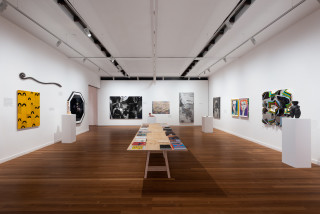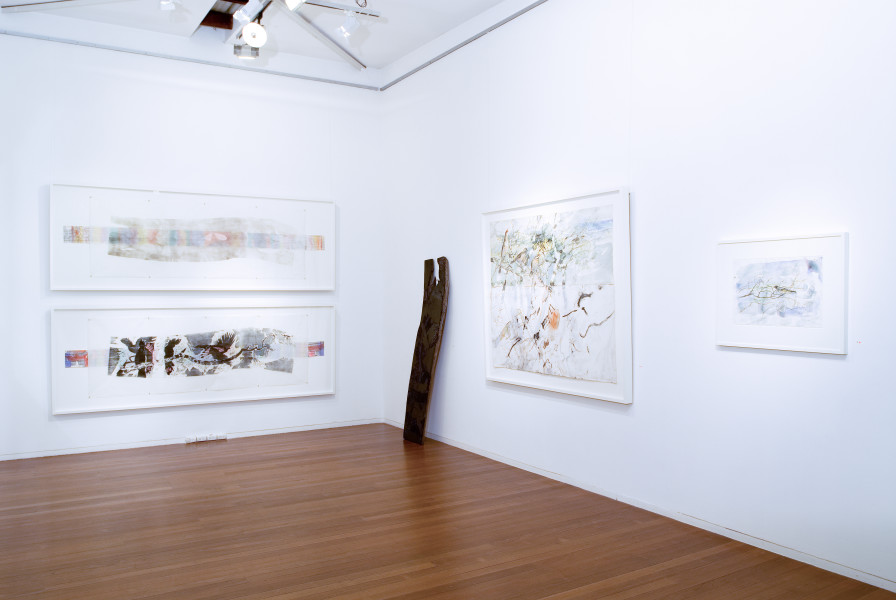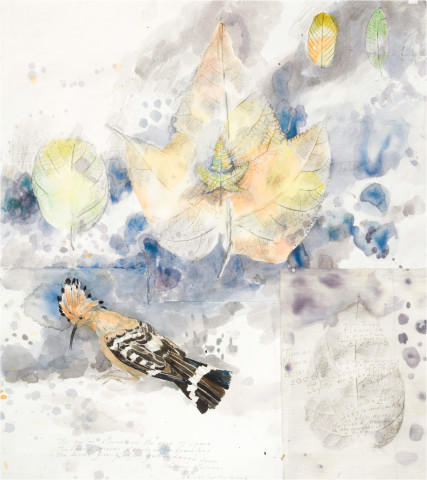I stumbled across a plank of Huon Pine from Lake Pedder last year. It had a wonderful grain like Time's finger print. Out of it, gauging and scooping, I cut the images of several Red-Tailed Black-Cockatoos. And sometimes as my engraving tool moved across the sixteen thousand years of growth rings I felt within Time in some strange immanent sense.
—John Wolseley
Exhibition Dates: 7 September – 30 September 2006
I stumbled across a plank of Huon Pine from Lake Pedder last year. It had a wonderful grain like Time's finger print. Out of it, gauging and scooping, I cut the images of several Red-Tailed Black-Cockatoos. And sometimes as my engraving tool moved across the sixteen thousand years of growth rings I felt within Time in some strange immanent sense. And yet because these were the images of the threatened 'graptogene' species of Red-Tailed Black-Cockatoo well on its way to extinction, and the wood was from an endangered tree, I sometimes felt I was near the end of something—being pushed off the gang-plank of Time as it were.
Before cutting into the great slab of ancient Huon pine I simply printed it as it was. The plank reminded me of those pieces of wood or stone which were searched out by the Chinese and were treasured as 'The uncarved block' and represented those hidden veins and energy flows—chi—which lies beneath the surface of nature. A friend, visiting my studio, remarked how it was an image of 'the world'. I liked that because it did seem like an image of land; the grain of the wood coming to the surface like the uppermost worn away surfaces of rock stratas.
Later I found that I had misheard him. He actually said it was a 'whirl'. I liked that too because the vascular tissue in the tree came to the surface in whirls and folded in on itself. And for me this was a metaphor of how we experience space and time—not flat or linear but folding in on itself like dough when you are making bread. Reminded me of the physicist David Bohm who talked of 'implicate' or enfolded order.'
The Wood, The World and The Parrot: Time's Cycle, Time's Arrow, was printed after I had engraved the cockatoos on the slab. As I was carving their images on to it, I was cutting through a tree which had laid down its layers of wood through all those years. The drought years had left filigree thin rings, the wetter years broader rings. As I sat in my camp in the Coboboony Forest and cut across these centuries of growth their cycle of seasons was echoed by the rhythm of another 'cycle of eternal return'—that of the Red-Tailed Black-Cockatoos which at the same time each evening passed with slow wing beats on their way to roost deep in the forest.
For Huon Pine with Cockatoo Timeline I printed the large slab of wood on thin translucent Japanese Paper. I then painted in watercolour a line of time which included the last mass extinction of species (and the dinosaurs) 65 million years ago and the surprisingly fast multiplication of bird species from about 55 million years ago including the first known parrot. The progression of vertical time segments in different colours can be seen glowing through the paper as they move under the print—as they travel through the Cretaceous, Paleocene, and the rest of the Tertiary period and on to the present. The line of time emerges from the edge of the print, and can be seen as it enters the start of the 6th mass extinction caused by the arrival of a new animal Homo Sapiens. What is so fabulous for a scientific layman like myself is that this 65 million stretch is long enough to demonstrate that the earth does work as a self organising organism kept in equilibrium through countless cycles. Under this woodcut lies the great progression of geological and biological cycles of death and regeneration - even the land and sea changing position in an endless dance. In other words linear time, if seen over a long enough stretch, proves itself to be made up of successive cycles of Time - what the great geologist Hutton called Uniformitarianism. As Stephen Jay Gould said in his wonderful book—Times Arrow, Times Cycle —'Fundamental states are immanent in time, always present and never changing. Apparent motions are part of repeating cycles and differences of the past will be realities of the future. Time has no direction'.
I began to realise that in my woodcut project, I had stumbled on what Gould called a crucial dichotomy which 'embodies the central subject of Time's linear and circular visions, or 'Times Arrow and Times Cycle.'
One idea of 'Times Cycle' shared by artists, poets and the first peoples of all continents is that time is made of repeating patterns and has an immanent geometrical logic. 'Times Arrow' is that other more mundane description of time - the idea that it stretches in a straight line back through the past and forward to the future. This idea of time as a line has had profound effects on modern human thought and is the concept that we contemporary humans tend to be locked into. Without linear time we could not have had our scientific and technological revolutions or recognized the kind of cosmic evolution embedded in the idea of cyclic time. And without 'Times Arrow' we may not have created what may be the conditions for humankind's nemesis - the cult of exponential growth, ideals of materialist progress and even perhaps the demise of those Red-Tailed Black-Cockatoos.
Curiously, I found a kind of consolation in this immersion in the deep time of these cockatoos. A cyclic view of Time—Deep Time in the sense of the Hindu eons or Lovelock's Gaia—is compatible with the idea that what will disappear from the earth may return in some equivalent form. A catastrophe caused the extinction of most bird species 65 million years ago; and since then nine thousand species have evolved. Now we ourselves are the catastrophe; and may be causing a comparable mass extinction of species—and in the process our own demise. But who is to say that the birds will not return, and maybe 'some kind of us'?. This is not to suggest that we do nothing about our present crisis. Like so many others I spend some of my time in a state of quiet desperation about what is happening and how the kind of action urgently needed is not being implemented. I am ashamed that it is our government together with the who are the most inactive. But sometimes when I despair about humankind's perversity and inability to think in the long term, I try to remember those other modalities and dimensions of human vision which at the end of the day may be the most profound and true. I try to recall those mysterious times when we have a sense of something far more deeply inter-fused, mysterious intimations of certainty—of a kind of cosmic hope. That moment listening to a Beethoven quartet. Or looking at Tintoretto's Suzannah and the Elders. Or in the desert looking at the night sky. Or when looking at the great revolutions of geological time. Or the deep time of birds. For myself all I can say is that I have found engraving these cockatoos in cyclic time strangely comforting.
In the series of works Birdsongs of Central Australia, I have been continuing my researches into methods of describing sound in graphic form. These drawings were made during an artists' camp organised by Birds Australia in their Newhaven conservation reserve, 400kms North of Alice Springs. I wrote in my diary at the time; 'I spent the day high on a red quartzite ridge where I found spindly sketetons of grevilleas and wattles burnt by bush fire. The Minni Ritchi Wattle had the most beautiful lizard scaly bark, and in a kind of stumbling dance I moved my paper on drawing boards across and within them. The burnt carbon marks they made looked almost like the notations of a musical score, and had an uncanny synaesthesia with the song of Singing Honeyeaters which flickered through those trees. Later when I had drawn the minutiae of leaves and feathers within my rubbed charcoal marks, I started to draw a 'sonogram' or graphic representation of a Singing Honeyeater's sweet scratchy voice. Suddenly one of these birds perched on a branch two metres from my drawing and sang the very notes I was inscribing'. Sonograms are made by passing the sound of the bird-song through a computer program. And they are a graph of the two most important variables of sound; harmonic frequency and the passage of time. They are able to depict the timbre of a bird's song in a more visual way than traditional musical notations. Later I camped in the Simpson Desert near Erldunda, and drew the sonograms of several more birds. In these works I have re-drawn the computer generated sonograms using the carbonised woods from the trees where the birds were singing.
The work Song of sea, sand and salt—Monibeong was started when I went on the Great South West Walk Art Project arranged by Carmel Wallace and Ilka White. Last April, eight artists walked some 250kms from the Cobobooney Forest, to the Glenelg River and then back along the coast to Portland. Lake Monebeong is a fresh water lake amongst sand dunes. I drew these Spiny-checked Honeyeaters singing a dawn chorus, buffeted by a high wind and sea spray. Below the soft exuberant birds are the blackened branches of coastal scrub after fire.
—John Wolseley
—
An exhibition of John Wolseley and Tony Clark’s paintings, entitled A Bird in the Hand, is being held at La Trobe University Visual Arts Centre Gallery (opening 30 September) and the Art Gallery of New South Wales (6 December 2006 – 28 January 2007) – curated by Robyn McKenzie. He was included in 2004 – Australian Art Now at Federation Square – National Gallery of Victoria in 2004. Wolseley is represented in all state galleries and numerous public and private collections both in and in. A monograph, John Wolseley: Land Marks by Sasha Grishin was published in 1998 by Craftsman House. The second edition will be available from November 2006, and will include new chapters spanning the artists work from 1998 to the present. In 2005 John Wolseley was made an Honorary Doctor of Science by Macquarie University and was also awarded the Visual Art Emeritus Award by the Australia Council. The Wood, the World and the Parrot is John Wolseley’s third solo exhibition with Roslyn Oxley9 Gallery.

woodcut over watercolour, graphite, ink and gouache on paper
101 x 284.5 cm; (frame size)

woodcut over watercolour, graphite in and gouache on paper
101 x 284.5 cm; (frame size)
Edition of 5

watercolour, graphite carbonised wood on paper
151.5 x 175.5 cm

watercolour, graphite, carbonised wood on paper
66 x 85.5 cm; (frame size)

watercolour, graphite, carbonised wood on paper
66 x 85.5 cm; (frame size)

watercolour, graphite, carbonised wood on paper
66 x 85.5 cm; (frame size)

watercolour, graphite, carbonised wood on paper
66 x 85.5 cm; (frame size)
 Group Show, The First 40 Years
Group Show, The First 40 Years
Roslyn Oxley9 Gallery, 2024
 John Wolseley Regenesis - Slow Water - Deep Earth.
John Wolseley Regenesis - Slow Water - Deep Earth.
Roslyn Oxley9 Gallery, 2023
 Group Show, Still Life
Group Show, Still Life
Buxton Contemporary, 2022
 John Wolseley One Hundred and One Insect Life Stories
John Wolseley One Hundred and One Insect Life Stories
Roslyn Oxley9 Gallery, 2019
 John Wolseley Heartlands and Headwaters
John Wolseley Heartlands and Headwaters
National Gallery of Victoria, Melbourne, 2015
John Wolseley all our relations
18th Biennale of Sydney, 2012
 John Wolseley Carboniferous
John Wolseley Carboniferous
Roslyn Oxley9 Gallery, 2010
 John Wolseley Natural Selection: MALLEE/MAQUIS
John Wolseley Natural Selection: MALLEE/MAQUIS
Roslyn Oxley9 Gallery, 2008
 Group Show, STOLEN RITUAL
Group Show, STOLEN RITUAL
Roslyn Oxley9 Gallery, 2006-07
 John Wolseley The Wood, The World, and The Parrot
John Wolseley The Wood, The World, and The Parrot
Roslyn Oxley9 Gallery, 2006
 John Wolseley Bird on a Wire
John Wolseley Bird on a Wire
Roslyn Oxley9 Gallery, 2005
 Group Show, Dirty Dozen
Group Show, Dirty Dozen
Roslyn Oxley9 Gallery, 2002
 Group Show, The First 20 Years
Group Show, The First 20 Years
Roslyn Oxley9 Gallery, 2002
 John Wolseley Tracing The Wallace Line
John Wolseley Tracing The Wallace Line
Roslyn Oxley9 Gallery, 2001
 Group Show, A constructed world (in collaboration with John Wolseley)
Group Show, A constructed world (in collaboration with John Wolseley)
Roslyn Oxley9 Gallery, 1997










